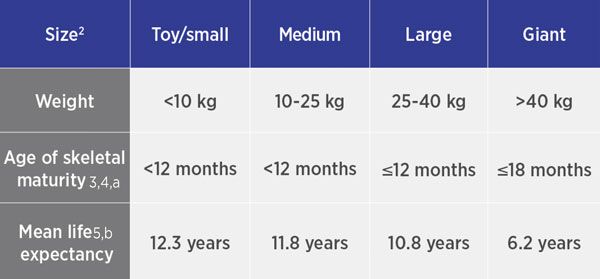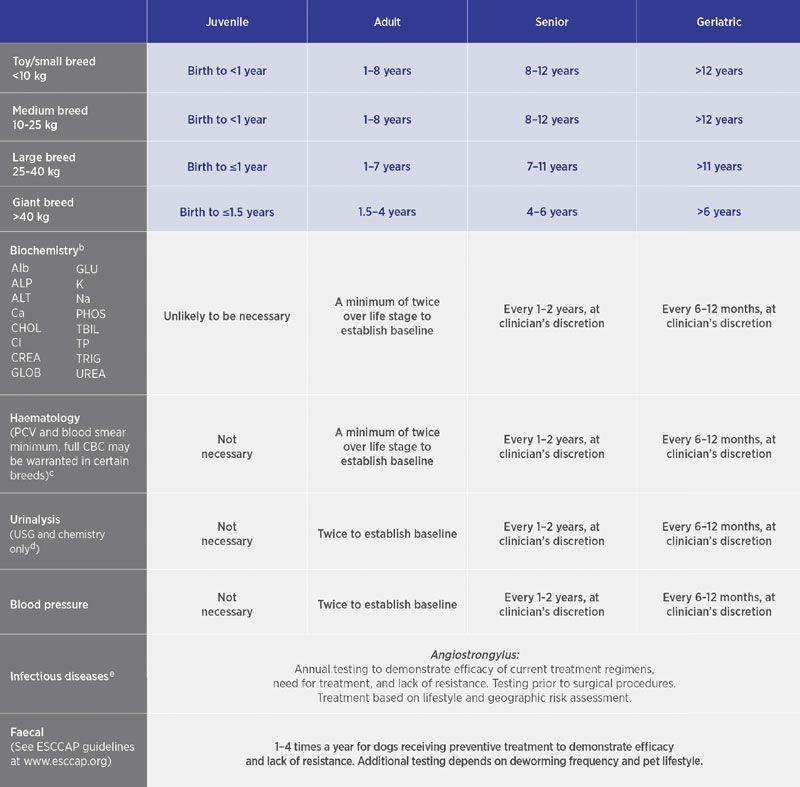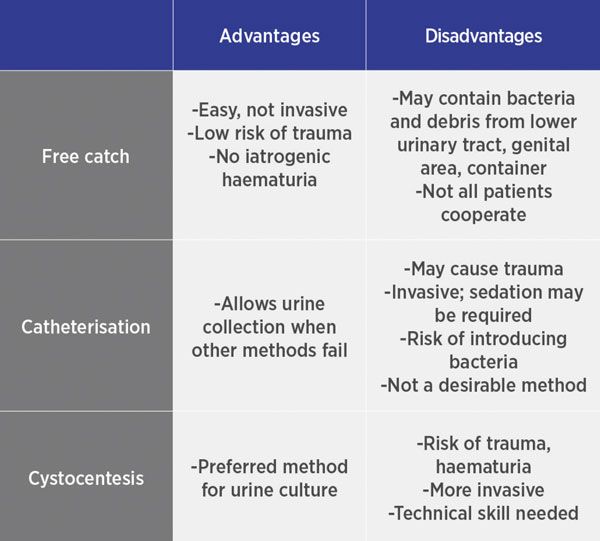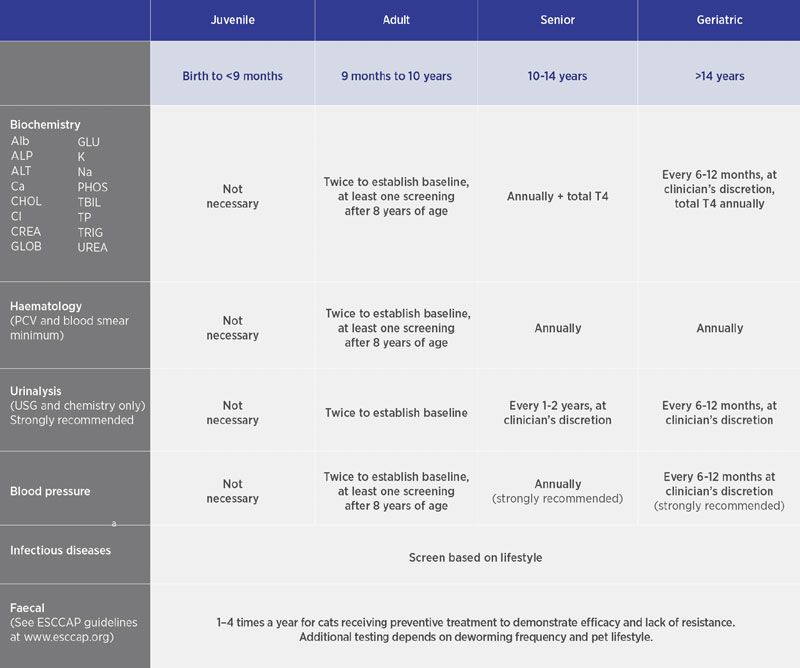Life Stage Diagnostic Health Screenings for Dogs and Cats
Although examples of life stage guidelines currently exist for dogs and cats internationally, none are tailored regionally to Ireland and the UK. Recently six veterinarians from Ireland and the UK (see Life Stage Health Screenings Panel details below) collaborated on best practice recommendations which are outlined in this article
The best practice recommendations bring together different perspectives from internal medicine, clinical pathology, parasitology, and general practice.
These guidelines are designed exclusively for laboratory screening of healthy, rather than clinically ill, pets. Diagnostic testing of clinically ill pets may require more comprehensive testing or more organ-specific diagnostic assays, depending on the case. Whether the pet is healthy or ill, all laboratory tests should be interpreted with the patient’s physical examination and history in mind. Recommendations are based on the optimum model of committed pet owners who are willing and able to bring their animals to the veterinarian for individual assessment.
The panel recognises that socioeconomic considerations and individual pet factors may determine the type and frequency of life stage testing that is performed. Therefore, these guidelines represent the core, or minimum, recommendations for each life stage. Breeds predisposed to certain disease conditions may require additional testing. For a comprehensive list, refer to Breed Predispositions to Disease in Dogs and Cats1 .
THE IMPORTANCE OF HEALTH SCREENINGS
Pet owners often miss or may dismiss clinical signs that are subtle or gradual in onset, and even the most thorough physical veterinary examination may not reveal underlying disease processes. Laboratory screening in visibly healthy pets provides veterinarians with the opportunity to assess organ function and identify underlying disease before the patient shows signs of illness. Results within the reference intervals reassure the owners that significant disease has not been detected at that time.
Establishing baseline values when the pet is healthy also provides a foundation for what is normal for an individual animal. Subsequent periodic laboratory screening can be used to monitor trends and identify subtle changes. When evaluated in conjunction with the physical examination and history, this data empowers veterinarians to deliver more individualised care, as well as detect and manage disease at earlier stages. Screening of healthy patients can therefore be just as important as performing diagnostic testing on patients that are ill.
In addition to the patient history, physical examination, and laboratory tests, other preventive care recommendations should be tailored to the pet’s health and lifestyle. Dr. Emma Evans notes: “So much can be gleaned from a laboratory test, especially early in the disease process, compared with the clinical examination alone. Many disease processes can be stabilised more quickly and efficiently in the early stages.”
LIFE STAGE HEALTH SCREENINGS PANEL
Sheila Brennan MVB Dip ECVIM-CA
Emma Evans MRCVS CertAVP (SAM & Derm) BVSc
Peter Graham BVMS PhD CertVR Dip ECVCP MRCVS
Scott Kilpatrick BSc (Hon) MSc BVM&S Dip ECVIM-CA MRCVS
Kit Sturgess MA VetMB PhD CertVR DSAM CertVC FRCVS
Ian Wright BVMS MSc MRCVS
Zoetis facilitated the panel discussion and development of this consensus statement in recognition of the importance of establishing specific life stage guidelines for pets in Ireland and the UK. All photos and graphics, courtesy of Zoetis.

Table 1: Canine life stages.
LIFE STAGES
The panel set a goal to define life stages that were biologically relevant, or where clinicians might expect to see changes in laboratory results. Dr Peter Graham explains: “If the aim is to have guidelines of appropriate laboratory tests that are useful for different stages, it’s sensible to pick times in life when laboratory results are likely to change or where the risk of subclinical disease is most likely to occur.”
CANINE LIFE STAGES
The juvenile life stage was defined as birth to skeletal maturity, or the point at which elevations in alkaline phosphatase (ALP), phosphorus, and calcium associated with bone growth should adjust to levels expected in a mature animal. The age of skeletal maturity will vary depending on dog size (see Table 2).
It was decided the adult life stage should span from skeletal maturity to two-thirds of the pet’s expected lifespan. During this stage, laboratory results are expected to be relatively normal, since most dogs have not yet reached a point where subtle organ diseases become a problem.
The senior life stage consists of approximately the last third of the dog’s expected lifespan. This life stage reflects the senescent phase of an animal’s life, in which age-related diseases can become more prevalent with subsequent impact on the pet’s quality of life. The senior years indicate the patient’s potential for decline in biological homeostasis, which includes, but is not limited to physical condition, physiological status, immunological function, cognition, and metabolism. More frequent screening may be considered to identify subclinical problems.
Finally, the geriatric life stage is defined as the years approaching life expectancy and beyond. These pets usually show signs of ageing and loss of muscle condition and are likely to have health issues or be receiving medications. Depending on the dog’s condition, health screenings may be needed more frequently, and other more targeted tests and interventions may be necessary. Dr. Kit Sturgess underlines the critical value of the senior phase: “It is probably the most important one because that’s when early diagnosis can have the greatest impact on longevity.”

a Skeletal maturity based on approximate latest closure times of the growth plates in the long bones of an average 25- to 30-kg dog. This will vary based on the individual. No data are published for toy/small-breed dogs; however, it is generally accepted that epiphyseal closure occurs earlier in smaller animals.
b Mean life expectancy calculated from the median life expectancy of breeds involved in the study, based on their size. Breed size established from The Kennel Club (UK) (https://www.thekennelclub.org.uk/search/breeds-a-to-z/) and the American Kennel Club (https://www.akc.org/dog-breeds/).
Table 2: Age of skeletal maturity and mean life expectancy by dog size.
FELINE LIFE STAGES
Like dogs, the feline juvenile life stage is also defined as birth to skeletal maturity. Since cats are more homogeneous in size than dogs, the panel decided that age could be used to define other life stages. The adult life stage spans from skeletal maturity to 10 years of age. Again, these are generally healthy animals. Cats from 10 to 14 years of age are considered seniors, and the geriatric life stage begins at 14 years of age.

a Final closure of the distal radial physis can occur in cats as late as 20 months of age.4
Table 3: Feline life stages.
ESTABLISHING PATIENT BASELINE VALUES
Whether laboratory work is performed in-house or at a commercial laboratory, the normal reference values provided are typically based on a mixed population of healthy dogs or cats within a geographic area. However, what’s ‘normal’ for an individual pet may fall anywhere within or even outside of that reference interval. Establishing a baseline, or individual reference interval, for each pet empowers the clinician to deliver more precise, individualised care. With testing at regular intervals in the animal’s life, clinicians can monitor trends and recognise potential diseases earlier. Ideally, all tests should be performed with the same laboratory equipment or location for consistency when comparing results over the lifespan of a pet. “The baseline is about creating that individual’s own reference interval because we know that a proportion of animals will always fall outside any reference interval,” says Dr Sheila Brennan. “That individual baseline may be different from the rest of the population.”
BIOCHEMISTRY
For health screening, biochemistry testing helps provide a general overview of the internal organ systems. Results outside the reference interval may serve as a trigger point, indicating that additional, more targeted testing or investigation is needed. As a group, the panel selected the core analytes that are recommended for health screenings, which are listed in the Life Stage Health Screening tables (Tables 4 and 6).
The panel consensus was that routine biochemistry health screening was unlikely to be necessary in juvenile dogs or cats because abnormalities, other than those associated with bone growth, are rare. There may be circumstances in which juvenile health screening can enable detection of congenital diseases; however, the prevalence of such conditions is considered too low to merit the blanket screening of all juvenile pets. Furthermore, dogs and cats with congenital diseases are likely to present with clinical signs, requiring a diagnostic workup.
Certain circumstances, such as pre-anaesthetic assessment and screening for breed-associated conditions, may require testing during the juvenile stage. Juvenile pets that are clinically ill will also need testing, but this is considered diagnostic testing rather than health screening.
Because bone growth during the juvenile stage in dogs can lead to transient elevations in ALP, phosphorus, and calcium, the panel agreed that baseline testing should not begin until the adult stage, when these values have stabilised. For most laboratory parameters, it is recommended that a minimum of two tests during the adult stage be performed to establish a baseline of what is considered normal for an individual dog that is deemed to be healthy.
In cats, screening twice during the adult life stage is also recommended, with at least one test between eight and 10 years of age, when some disease processes such as hyperthyroidism may begin.
Annual biochemistry screening may be warranted for senior dogs. Clinicians may opt to extend screening to every two years in healthy dogs with a track record of stable test results that fall within the normal reference interval. Because cats may be more likely to develop certain diseases during the senior life stage, annual biochemistry screening is recommended, including a total T4 to detect hyperthyroidism. Biochemistry testing is recommended in geriatric dogs and cats every six to 12 months, at the clinician’s discretion, to identify disease processes that may develop more rapidly during this life stage. Annual total T4 screening is also recommended for geriatric cats.
HAEMATOLOGY
When screening healthy animals, haematology should complement biochemistry, so the panel recommends performing both tests at the same time. For ease and convenience in a busy practice, haematology can be performed with an automated complete blood count (CBC) analysis.
There may be circumstances, such as small sample size or volume or financial constraints, in which the panel recommends a minimum of a packed cell volume (PCV) and a blood smear evaluation. A PCV can be helpful in identifying subtle anaemia or polycythaemia. White blood cell counts tend to be too variable to be of value for baseline monitoring.
If abnormalities are identified, or breed predispositions exist, a full CBC, with blood smear, should be performed. “There may be breed predispositions that you’d like to know about haematologically,” Dr Peter Graham states. “You might like to know if that Cavalier has a low platelet number or your poodle’s got macrocytosis while it’s healthy, so that doesn’t confuse the picture when the dog is unhealthy.”
OTHER LABORATORY TESTS
TOTAL T4
The panel questioned the value of routinely screening T4 in apparently healthy dogs. Abnormal T4 results that are slightly out of reference interval in asymptomatic dogs can be difficult to interpret; therefore, it is recommended that T4 assessment only be performed in canine patients demonstrating clinical signs suggestive of hypothyroidism. Typically, these dogs will also have abnormalities in their biochemistry results, such as ALP, cholesterol, or triglycerides, to further justify testing.
However, because hyperthyroidism is so common in cats as they age, total T4 screening is recommended annually in both senior and geriatric life stages.

a Canine ages have been rounded to the nearest year.
b Consider additional testing for breeds predisposed to biochemical abnormalities. A total T4 test is only recommended in dogs with clinical signs.
c Consider a CBC with blood smear for breeds predisposed to haematologic abnormalities.
d Consider a full urinalysis with sediment analysis for breeds predisposed to renal abnormalities.
e Consider appropriate testing for traveled or imported dogs.
Table 4: Canine life stage health screeninga.
SDMA
As a whole, the panel did not believe the literature currently supports the value of regular symmetric dimethylarginine (SDMA) testing in healthy animals. The test may be warranted for breeds predisposed to renal conditions, but it was generally agreed that monitoring urine specific gravity (USG), creatinine, and urea is most helpful for screening healthy pets.
C-REACTIVE PROTEIN
C-reactive protein (CRP) is an acute-phase protein that is a sensitive marker of systemic inflammation in dogs. As such, the panel felt it is more useful as a diagnostic test in clinically ill dogs than as a screening test in healthy dogs.
URINALYSIS
For screening of healthy pets, the panel agreed that fresh, free-catch samples are acceptable. In dogs, owners can obtain a sample during normal voiding. For cats, a sample can be obtained by using non-absorbable litter in litter trays.
The advantage of a free-catch sample is that it is non-invasive and there is minimal to no risk to the pet. While samples may be contaminated with cells, bacteria, and debris from the urethra, genital tract, and skin, the urine sediment is not the critical part of this test in healthy pets.
USG (measured with a refractometer) and urine chemistry should be obtained at the same time as blood biochemistry and haematology tests. Like other laboratory tests, baseline readings when the pet is healthy can help clinicians monitor for subtle changes and trends over the lifetime of the individual pet. Dipstick proteins should be evaluated alongside the USG because if the urine is diluted, the trace protein reading may be significant. Because renal disease is so common in older cats, the panel strongly recommends regular urine screening in senior and geriatric cats. Dr. Scott Kilpatrick adds: “Urinalysis is an extremely useful and probably underutilised tool. The specific gravity is the most useful part of it.”
BLOOD PRESSURE MEASUREMENT
Regular blood pressure measurement is recommended in both dogs and cats and should be considered part of the routine health screening. Serial blood pressure measurements over the course of an animal’s life can help clinicians identify and treat hypertension earlier in the disease process.

a Manual compression of the urinary bladder is not recommended.
Table 5: Advantages and disadvantages of various urine collection methods.

a Consider appropriate testing for traveled or imported cats. See 2020 AAFP Retrovirus Testing Guidelines.
Table 6: Feline life stage health screening.
INFECTIOUS DISEASE TESTING
Part of every health screening should include discussions with the owner about their pet’s lifestyle, history of travel or importation, and risk for infectious diseases. Given the expanded host ranges for Angiostrongylus, deworming history and lifestyle factors predisposing dogs to exposure to Angiostrongylus vasorum should be discussed as well. If a dog presents with relevant clinical signs (e.g., respiratory, coagulopathy), or if lifestyle and geographic factors indicate high risk of exposure (e.g., known endemic areas, coprophagia, known mollusc and/or grass consumption) and there is an uncertain deworming history, clinicians should either test or treat for this parasite.
Younger dogs have been demonstrated to be at higher risk of exposure, and coagulopathies represent a potential risk to surgical patients. Therefore, there is benefit in routinely testing dogs for A. vasorum before surgery as well as testing young adult dogs annually. Routine annual testing of young dogs receiving preventive treatment regimens is beneficial to demonstrate adequate compliance and treatment efficacy and as a mechanism for early detection of drug resistance.
In terms of retrovirus (FeLV and FIV) testing in cats, the task force believes the risks are more associated with lifestyle than with a life stage. For more guidance, see the 2020 American Association of Feline Practitioners (AAFP) Feline Retrovirus Testing and Management Guidelines, which are endorsed by the International Society of Feline Medicine (ISFM)6, available at: https://journals.sagepub.com/doi/ pdf/10.1177/1098612X19895940/
FAECAL TESTING
The panel supports the European Scientific Counsel Companion Animal Parasites (ESCCAP) guidelines7 : “Parasite infections should be controlled through endoparasite and ectoparasite management and treatment. Few parasite infections are strictly age-related; the risk continues as the animal ages and so consideration should be given to provide each dog and cat with appropriate worm control throughout its lifetime. The routine treatment and prevention of all worms depends upon legislation in individual countries, veterinary professionals taking local epidemiological circumstances into account, owner perception and individual risk assessments i.e. hunting pets, previous lungworm exposure, raw meat diets etc.” Puppies and kittens are at increased risk of Toxocara infection via transplacental (puppies) and transmammary (puppies and kittens) routes of infection and should, therefore, be treated monthly until at least six months old.
If faecal testing is used to replace routine roundworm treatment from age six months, then it will need to be carried out at least four times a year and in some cases monthly, depending on lifestyle risk of infection (pets that hunt, those in close association with children and/or immunosuppressed individuals). If this strategy is undertaken, pet owners must understand zoonotic eggs can be shed between tests.
Routine faecal testing for roundworms carried out one to four times per year is useful in cats and dogs receiving preventive treatment to demonstrate adequate compliance and treatment efficacy and as a mechanism for early detection of drug resistance. Routine testing is not currently useful for tapeworm surveillance as faecal testing does not carry a high sensitivity for tapeworm detection (with the exception of Echinococcus polymerase chain reaction [PCR] tests). Preventive treatment for tapeworms should therefore be based on a lifestyle risk assessment.
Dr Ian Wright notes the particular benefit of faecal testing: “Without routine faecal testing, we are blind in regard to whether treatment is being correctly administered at an adequate frequency and as to whether anthelmintic resistance is developing.”
CONCLUSION
Promoting wellness and disease prevention through routine diagnostic health screenings is a powerful way to improve patients’ quality of life. Early diagnosis of underlying diseases enables veterinarians to intervene when treatment is often more effective and more affordable.
Tables 4 and 6 provide a summary of the expert panel’s recommendations for laboratory health screenings in dogs and cats, specifically for the United Kingdom and Ireland. Dr Scott Kilpatrick sums up the value of screening: “Laboratory health screening is about empowering people to do better for their pets.”
- Gough A, Thomas A, O’Neill D. Breed Predispositions to Disease in Dogs and Cats. Wiley-Blackwell; 2018.
- Hawthorne AJ, Booles D, Nugent P, Gettinby G, Wilkinson J. Body-weight changes during growth of puppies of different breeds. J Nutr. 2004;134:2027S-2030S.
- Von Pfeil DJ, DeCamp CE. The epiphyseal plate: physiology, anatomy, and trauma. Compend Contin Educ Vet. 2009;31(8):E1-E11.
- Smith RN. The developing skeleton. J Am Vet Rad Soc. 1963;9:30-36.
- O’Neill DG, Church DB, McGreevy PD, Thomson PC, Brodbelt DC. Longevity and mortality of owned dogs in England. Vet J. 2013;198(3):638-643.
- Little S, Levy J, Hartmann K, et al. 2020 AAFP feline retrovirus testing and management guidelines. J Feline Med Surg. 2020;22:5-30.
- European Scientific Counsel Companion Animal Parasites. Worm control in dogs and cats. ESCCAP Guideline 01 Sixth Edition—May 2021. Accessed March 9, 2022. https://www.esccap.org/uploads/docs/oc1bt50t_0778_ESCCAP_GL1_v15_1p.pdf















